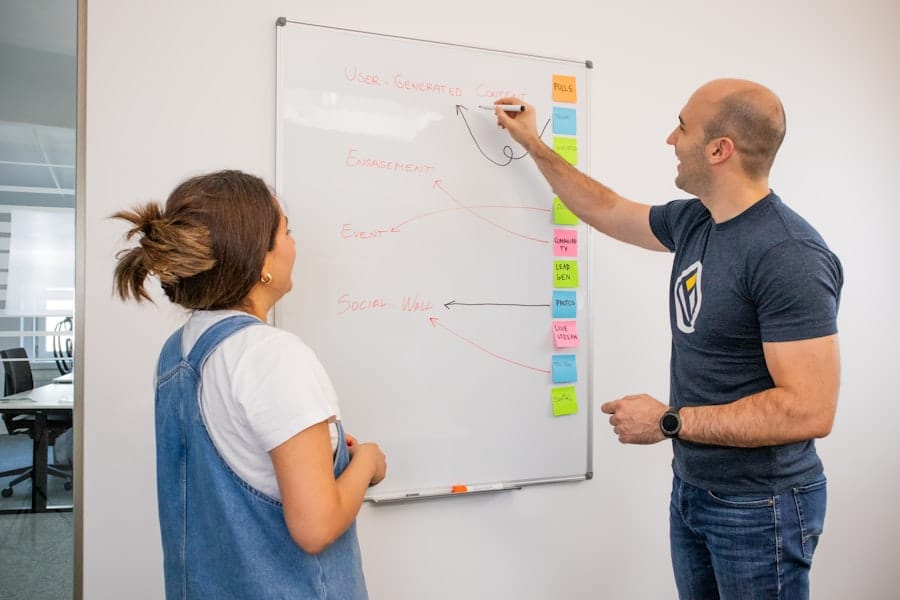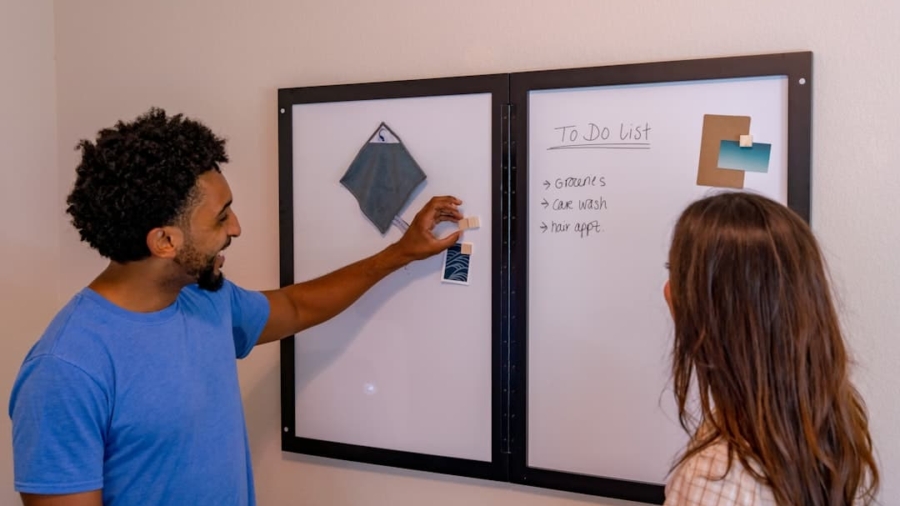Blended learning represents a transformative approach to education that combines traditional face-to-face instruction with online learning components. This model leverages the strengths of both modalities, allowing for a more personalized and flexible educational experience. The integration of technology into the classroom has not only changed how educators deliver content but also how students engage with it.
In a blended learning environment, students can access resources at their own pace, revisit challenging concepts, and collaborate with peers in innovative ways. This shift is particularly significant in an era where digital literacy is paramount, and the demand for adaptable learning solutions continues to grow. The concept of blended learning encompasses various models, each tailored to meet the diverse needs of learners.
For instance, the rotation model allows students to alternate between online and in-person instruction, while the flex model provides a more fluid approach where online learning is the primary mode, supplemented by occasional face-to-face interactions. Other models, such as the enriched virtual model, offer a fully online experience with scheduled in-person sessions. These varied approaches enable educators to design curricula that cater to different learning styles and preferences, fostering an inclusive environment that promotes engagement and achievement.
Key Takeaways
- Blended learning combines traditional classroom teaching with online learning tools and resources to enhance the learning experience for students.
- Case study 1 highlights the successes of implementing blended learning, but also the challenges such as technology integration and teacher training.
- Case study 2 outlines best practices for blended learning in the classroom, including personalized learning, student engagement, and data-driven instruction.
- Blended learning has been shown to have a positive impact on student achievement, with improved test scores, engagement, and retention of material.
- Teacher training and support are crucial for successful blended learning implementation, including professional development and ongoing mentorship.
Case Study 1: Successes and Challenges of Implementing Blended Learning
One notable case study highlighting the successes and challenges of blended learning implementation can be found in a suburban high school in California. The school district embarked on a comprehensive initiative to integrate blended learning across its curriculum, aiming to enhance student engagement and improve academic outcomes. Initially, the program saw significant successes; students reported increased motivation and a greater sense of ownership over their learning.
The flexibility of accessing materials online allowed students to learn at their own pace, which was particularly beneficial for those who struggled with traditional teaching methods. However, the implementation was not without its challenges. One major hurdle was the disparity in students’ access to technology outside of school.
While many students thrived in the blended environment, others faced difficulties due to limited internet access or lack of devices at home. This digital divide highlighted the need for equitable access to technology as a critical component of successful blended learning initiatives. Additionally, some teachers expressed concerns about their preparedness to effectively facilitate blended learning experiences.
Professional development opportunities were essential in addressing these challenges, ensuring that educators felt confident in utilizing technology to enhance their teaching practices.
Case Study 2: Best Practices for Blended Learning in the Classroom

Another compelling case study comes from an urban middle school that successfully implemented blended learning through a well-structured framework. The school adopted a hybrid model that combined project-based learning with online resources, allowing students to engage deeply with content while developing critical thinking skills. Teachers collaborated to design interdisciplinary projects that incorporated technology, enabling students to explore real-world problems and apply their knowledge in meaningful ways.
This approach not only fostered collaboration among students but also encouraged them to take an active role in their learning journey. Best practices emerged from this case study that can serve as a guide for other educators looking to implement blended learning effectively. One key practice was the establishment of clear communication channels between teachers and students.
Regular check-ins and feedback sessions helped maintain accountability and provided opportunities for students to voice their concerns or seek clarification on assignments. Additionally, the use of data analytics played a crucial role in monitoring student progress.
This data-driven approach ensured that interventions were timely and targeted, ultimately leading to improved student outcomes.
Impact of Blended Learning on Student Achievement
The impact of blended learning on student achievement has been a focal point of numerous studies and educational initiatives. Research indicates that when implemented effectively, blended learning can lead to significant improvements in academic performance. For instance, a meta-analysis conducted by the U.S.
Department of Education found that students in blended learning environments performed better on average than those receiving traditional instruction alone. This improvement can be attributed to several factors inherent in blended learning models, such as personalized pacing, increased engagement through interactive content, and opportunities for collaborative learning. Moreover, blended learning has been shown to enhance critical skills that are essential for success in the 21st century.
Students engaged in blended environments often develop stronger self-regulation skills as they learn to manage their time and resources effectively. The ability to navigate online platforms fosters digital literacy, which is increasingly important in today’s technology-driven world. Additionally, blended learning encourages a growth mindset; students are more likely to embrace challenges and view setbacks as opportunities for growth when they have access to diverse resources and support systems.
Teacher Training and Support for Blended Learning
For blended learning to be successful, comprehensive teacher training and ongoing support are paramount. Educators must be equipped not only with the technical skills necessary to utilize digital tools but also with pedagogical strategies that enhance student engagement in a blended environment. Professional development programs should focus on integrating technology into lesson planning, understanding data analytics for tracking student progress, and fostering collaborative learning experiences among students.
Support systems within schools also play a critical role in sustaining blended learning initiatives. Establishing mentorship programs where experienced teachers guide their peers can create a culture of continuous improvement and innovation. Additionally, providing access to resources such as instructional coaches or technology specialists can help teachers troubleshoot challenges they encounter while implementing blended learning strategies.
By fostering an environment where educators feel supported and empowered, schools can maximize the potential of blended learning models.
Overcoming Barriers to Blended Learning Implementation

Despite its potential benefits, several barriers can hinder the successful implementation of blended learning initiatives. One significant challenge is resistance from stakeholders who may be skeptical about the effectiveness of technology in education. To address this concern, it is essential for school leaders to communicate the rationale behind adopting blended learning models clearly.
Sharing success stories from other institutions and providing data-driven evidence of improved student outcomes can help alleviate fears and garner support from parents, teachers, and administrators alike. Another barrier is the lack of infrastructure necessary for effective blended learning implementation. Schools must ensure that they have reliable internet access and adequate technological resources for both students and teachers.
This may involve investing in hardware such as laptops or tablets and ensuring that all classrooms are equipped with high-speed internet connections. Additionally, ongoing maintenance and technical support are crucial for addressing any issues that arise during implementation. By proactively tackling these barriers, schools can create an environment conducive to successful blended learning experiences.
Lessons Learned from Schools That Excelled with Blended Learning
Schools that have excelled in implementing blended learning often share common lessons that can inform future initiatives. One key takeaway is the importance of fostering a culture of collaboration among educators. Schools that prioritize teamwork and shared goals tend to see more successful outcomes in their blended learning programs.
Collaborative planning sessions allow teachers to align their curricula and share best practices, ultimately enhancing the overall quality of instruction. Another lesson learned is the significance of involving students in the design of blended learning experiences. When students have a voice in how they learn—whether through selecting topics for projects or choosing digital tools—they are more likely to be engaged and invested in their education.
Schools that actively seek student feedback on their experiences can make informed adjustments that better meet learners’ needs. This student-centered approach not only improves academic outcomes but also fosters a sense of community within the classroom.
The Future of Blended Learning in Education
As education continues to evolve in response to technological advancements and changing societal needs, blended learning is poised to play an increasingly vital role in shaping the future of teaching and learning. The flexibility inherent in blended models allows for greater personalization, enabling educators to tailor instruction to meet diverse learner needs effectively. Furthermore, as digital literacy becomes an essential skill for success in various fields, blending traditional teaching methods with online resources prepares students for the demands of the modern workforce.
Looking ahead, it is crucial for educational institutions to remain adaptable and open-minded about integrating new technologies into their curricula.
By embracing innovation while remaining focused on student-centered practices, schools can harness the full potential of blended learning to create enriching educational experiences that prepare students for success in an ever-changing world.
In exploring the success of blended learning models in schools, it’s insightful to consider how technology plays a pivotal role in enhancing educational experiences. A related article that delves into the impact of technology, albeit in a different context, is the Samsung Galaxy S23 Review. This review highlights the advancements in mobile technology, which can be leveraged in educational settings to support blended learning environments. By integrating such cutting-edge devices, schools can offer more interactive and engaging learning experiences, similar to those discussed in the case study of schools excelling with blended learning models.
FAQs
What is blended learning?
Blended learning is an educational approach that combines traditional face-to-face instruction with online learning activities. It allows for a more personalized and flexible learning experience for students.
What are some examples of blended learning models?
Some examples of blended learning models include the flipped classroom, station rotation, flex model, and a la carte model. Each model combines in-person instruction with online learning in different ways.
How have schools excelled with blended learning models?
Schools that have excelled with blended learning models have seen improved student engagement, personalized learning experiences, and increased academic achievement. These schools have effectively integrated technology into their curriculum and provided professional development for teachers.
What are the benefits of blended learning for students?
The benefits of blended learning for students include increased access to educational resources, personalized learning experiences, improved digital literacy, and the development of 21st-century skills such as collaboration and critical thinking.
How can schools implement successful blended learning models?
Schools can implement successful blended learning models by providing adequate technology infrastructure, offering professional development for teachers, creating a supportive learning environment, and continuously evaluating and adjusting the blended learning approach based on student outcomes.

